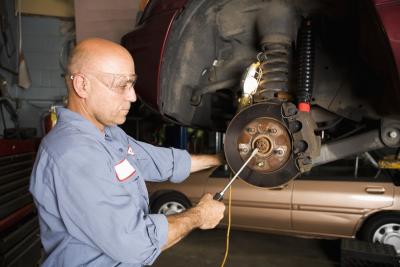
Brake rotors are the round steel part located behind your car's wheels that are clamped by the caliper and the brake pads when the brakes are applied. The friction from the brake pad material on the rotor is what slows the wheel. Over the years, several different types of rotors have been designed, from vented steel rotors to more exclusive carbon ceramic rotors used on extremely high-performance cars. High-performance brake rotors are a common upgrade for car owners who want to increase their car’s braking ability, though not all types of brake rotors are available for all cars.
Most brake rotors that are used on production cars are simply cast iron rotors of a variety of thicknesses and diameters.
Cross-drilled rotors have holes drilled through them. The holes are spread out over the entire surface of the brake rotor and help the rotor cool down during aggressive braking by dissipating the heat that is built up. Many performance cars come with cross-drilled rotors from the factory as a performance feature. This is also a popular upgrade for owners looking to improve their braking on a car that has standard rotors. Cross-drilled rotors also look great when you can see them through the spokes of the wheel. Poor quality cross-drilled rotors have been known to crack prematurely if the drilling is not done properly.
Vented rotors have vents or hollowed out veins inside the rotor and which are visible if you look at the edge of the rotor. Like cross-drilling, the vents help keep the rotors cool during braking. The vents in rotors are usually added as part of the casting process.
Like cross drilling and venting, slotted rotors are designed to improve the cooling ability of brake rotors. Slotted rotors have slots that are machined in the face of the rotor and that are directionally placed at an angle on the rotor.
Often performance brake rotors will combine different features, so it’s not uncommon to find rotors that are cross-drilled, slotted and vented for maximum cooling ability. Some rotors combine two of the features, such as slotting and cross-drilling.
Carbon-reinforced rotors have been around since the mid-1970s, when they were developed for use in Formula One racing. Carbon brakes are used primarily on racecars, where they can quickly get up to the high temperature that are needed for proper braking. Carbon-fiber reinforced ceramic brake rotors are the highest performance and most expensive brake rotors currently in use. Extremely high performance cars like the Ferrari Enzo, the latest Corvette ZR1 and the Porsche Carrera GT use ceramic brakes to great effect on road-going supercars.